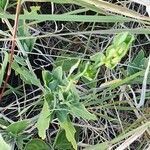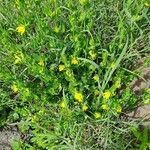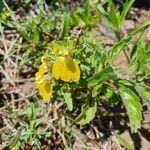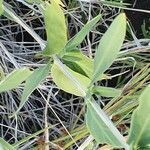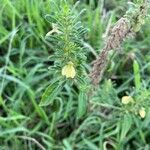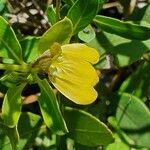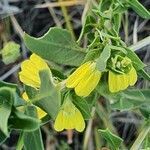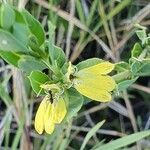Perennial herb or shrublet, 0.1-1.0(-2.0) m high. Stems herbaceous, may root at nodes. Leaves nearly glabrous to densely white-pilose especially on veins and margins, lanceolate to broadly ovate, 12-120 x 4-46 mm, apex obtuse to broadly acute, base cuneate to obtuse; petiole 1-25 mm long. Inflorescence terminal, a dense aggregate of sessile cymes in axils of reduced floral leaves. Bracts and bracteoles similar to floral leaves but smaller, always pubescent, narrowly lanceolate to oblanceolate, 7-14 mm long, apex acute or obtuse. Corolla 7-11 mm long, pale to greenish yellow with bright yellow lower lip, lower lip may have a dark stripe down each lobe. Pollen 3-colporate, 42-58 µm long, areolate. Capsule 4-seeded, delicate in texture, up to 9 mm long. Seeds rough, with 1(-many) crystal(s) per cell in testa.
A herb. It grows 50-120 cm high. It can be erect or trailing. It has fine hairs. The stem is woody at the base. The leaves are opposite. The leaf stalks are 1.5 cm long. The leaves are oval and 8 cm long by 3 cm wide. The flowers are in clusters at the end of the plant. This dense spike is 20 cm long. The flowers are yellow. The fruit is a 4 seeded capsule. It is 8 mm long. It is densely hairy and splits in half. The seeds are brown to black.
Perennial, dwarf shrub or herb, 0.1-1.0 m high. Leaves nearly glabrous to densely white-pilose, especially on veins and margins when very young, lanceolate to broadly ovate. Inflorescence a terminal, dense aggregate of sessile cymes in axils of reduced floral leaves. Bracts and bracteoles similar to floral leaves but smaller. Flowering time all year. Fruit a 4-seeded capsule.
Perennial herb or shrublet, 0.1-1.0(-2.0) m high. Inflorescence sessile axillary cymes, approximated at ends of branches; cymes each reduced to single pedunculate flower; in axils of reduced bract-like leaves. Corolla 7-11 mm long. Bracts and calyx densely pubescent but hairs not long and cottony. Flowers pale to greenish yellow with bright yellow lower lip.
Yellow dark-streaked flowers 1/3-1/2 in. long in pubescent spikes 2-6 in. or more long.
Herb, erect or straggling 1-4 ft., with pubescent sulcate stems
